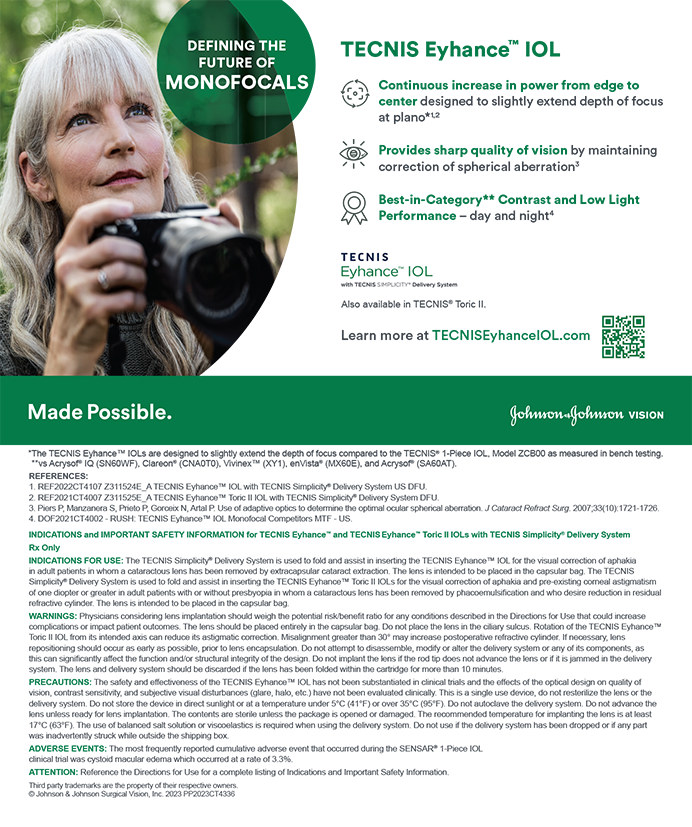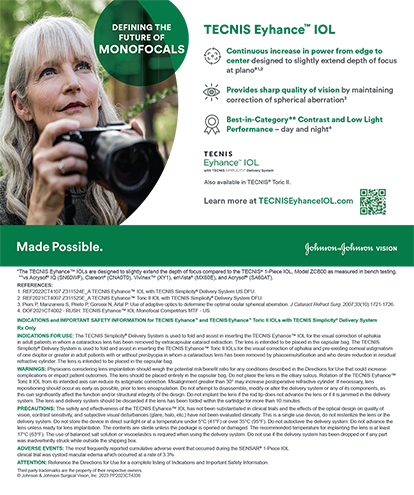I am always a generation behind in fashion. I began wearing bell-bottom pants just when they fell out of favor (Figure 1). It was the same with skinny ties. I have found, that, if I keep something long enough, however, it often comes back into style. Something akin to this phenomenon is occurring for me now in cataract surgery. Years ago, ophthalmologists performed the procedure without an ophthalmic viscosurgical device (OVD). Today, a femtosecond laser can create the capsulotomy and disassemble the nucleus in a closed chamber, which has allowed me to consider again performing these portions of the cataract procedure without the use of an OVD.
AN OVD's PURPOSE
What is the rationale for using an OVD during cataract surgery? Its primary purpose is to maintain the anterior chamber while the surgeon makes the incision, creates the capsulotomy, removes the cataract with phacoemulsification or an extracapsular technique, and implants the IOL. Additionally, an OVD's presence in the eye during nuclear and cortical removal helps to protect the corneal endothelium.
Unless the ophthalmologist uses a dispersive OVD, little to none will remain in the anterior chamber after the initiation of high-vacuum phacoemulsification. Unfortunately, bubbles and nuclear chips typically become trapped in a dispersive OVD, reducing followability, decreasing visualization, and requiring the surgeon to search through viscoelastic, near the endothelium and into the anterior chamber angles, in order to remove the nuclear pieces. I have found that the incidence of retained nuclear debris is higher when I use a dispersive versus a cohesive OVD. Again, however, the quick aspiration of the latter with high vacuum means little or no protection of the corneal endothelium during cataract extraction and cortical cleanup.
THE MOMENTUM OF CHANGE
The modification of one part of surgery opens the door to other changes that may improve a procedure. For example, in 2011, Stephen Slade, MD, was the first to consider abandoning hydrodissection in some cases of laser cataract surgery. His radical move sparked my interest. I began to question whether hydrodissection—and for that matter the instillation of an OVD—were needed prior to the IOL's implantation when the laser had successfully performed the capsulotomy.
I tried not injecting an OVD at the beginning of surgery in a few cases of moderate cataract, after which I observed the patients and evaluated the effects on their corneas. To my surprise, this technique was faster and produced similar results to the cases in which I continued to use an OVD.Intraoperatively, I was spared the annoyance of OVDentrapped bubbles or nuclear chips, and visibility was better. Moreover, corneas were clearer on postoperative day 1, I suspect because laser softening and division of the nucleus shortened my phaco time and I did not have to spend time searching for debris trapped near the endothelium. I also observed a complete absence of debris or lens epithelial cells under the residual anterior capsular rim (Figure 2).
My early results also indicate no difference in endothelial cell loss. I am continuing to monitor these patients with pachymetry and cell counts, but I do not expect a greater loss of cells over time in this group.
PROCEDURE
After the femtosecond laser successfully completes the incisions, creates the capsulotomy, and fragments the lens, I open the secondary incision in the OR with a LASIK spatula. I inject my usual methylparaben-free lidocaine with 1:25,000 epinephrine to firm the globe, provide additional anesthesia, and maintain pupillary dilation. I then tease open the posterior portion of the primary incision with a LASIK spatula. With irrigation on, I introduce the phaco tip through the primary incision while being careful not to allow the chamber to collapse.
I aspirate any bubbles present in the anterior chamber from the laser procedure. Before engaging aspiration or ultrasound power, however, I use the phaco tip to confirm that the capsulotomy is complete or to finish the tear in any areas that are not 100% free. After engaging aspiration, I remove the central free capsulotomy (Figure 3). Using the phaco tip and a second nucleus manipulator, I propagate the lens chops posteriorly and peripherally. Posterior bubbles typically come forward at this time and are easily aspirated, because there is no OVD to trap them.
I free and emulsify each quadrant in my usual fashion, but without hydrodissection, I occasionally must “shoehorn” free the subincisional quadrants with the second instrument. This process is more challenging when I am dealing with a cortical cataract, which typically has sticky cortical/ capsular attachments that have not been freed by hydrodissection. Cortical aspiration is routine, but there is no need to vacuum or polish the undersurface of the anterior capsular rim, because no debris remains. At this point, I inject a cohesive OVD to fill the capsular bag for the IOL's placement, as is my routine.
CONCLUSION
A common flaw among ophthalmologists is a failure to think outside the box. Surgeons get stuck in a routine, because it is comfortable and the results are already satisfactory. Ophthalmologists commonly ridicule any change that challenges the status quo. I suggest that the field can always improve and that ophthalmologists should remain open to change. As technology evolves, so should surgical technique—not for the sake of change but for a possible improvement in a procedure and patients' results. I cannot claim that my outcomes are better when I do not use an OVD at the start of the cataract procedure. Incorporating the femtosecond laser into refractive cataract procedures, however, does allow surgeons to explore technical changes of this sort that may lead to a better procedure.
Robert J. Cionni, MD, is the medical director of The Eye Institute of Utah in Salt Lake City, and he is an adjunct clinical professor at the Moran Eye Center of the University of Utah in Salt Lake City. He is a consultant to Alcon Laboratories, Inc. Dr. Cionni may be reached at (801) 266-2283.


